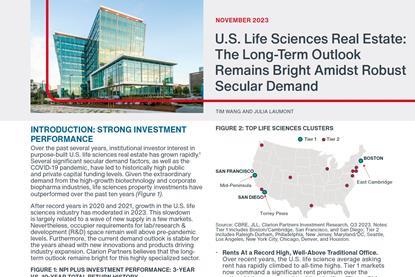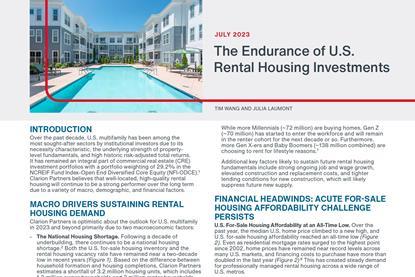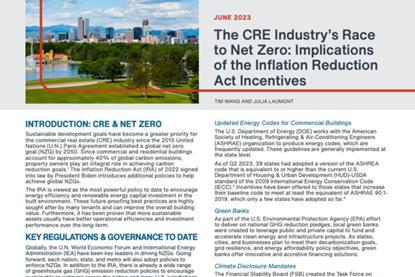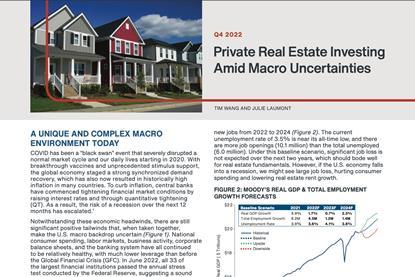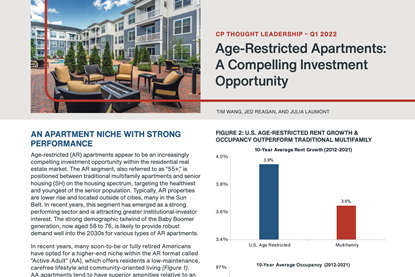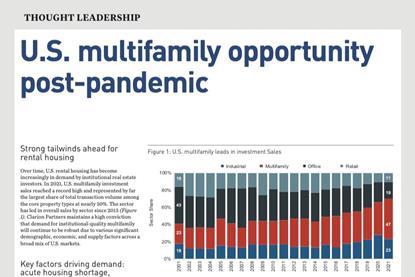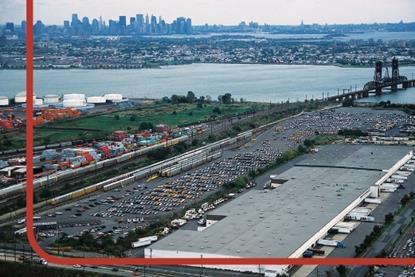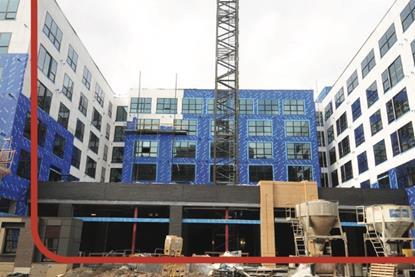Content (24)
-
White papers
U.S. Life Sciences Real Estate: The Long-Term Outlook Remains Bright Amidst Robust Secular Demand
Over the past several years, institutional investor interest in purpose-built U.S. life sciences real estate has grown rapidly.1 Several significant secular demand factors, as well as the COVID-19 pandemic, have led to historically high public and private capital funding levels.
-
White papers
The Endurance of U.S. Rental Housing Investments
Over the past decade, U.S. multifamily has been among the most sought-after sectors by institutional investors due to its necessity characteristic, the underlying strength of property-level fundamentals, and high historic risk-adjusted total returns. It has remained an integral part of commercial real estate (CRE) investment portfolios with a portfolio weighting of 29.2% in the NCREIF Fund Index-Open End Diversified Core Equity (NFI-ODCE).
-
White papers
The CRE Industry’s Race to Net Zero: Implications of the Inflation Reduction Act Incentives
Sustainable development goals have become a greater priority for the commercial real estate (CRE) industry since the 2015 United Nations (U.N.) Paris Agreement established a global net zero goal (NZG) by 2050.
-
White papers
Benefits of Private Real Estate in Volatile Markets
In recent years, institutional and retail investor allocations to private real estate have risen steadily.
-
White papers
Private Real Estate Investing Amid Macro Uncertainties
COVID has been a “black swan” event that severely disrupted a normal market cycle and our daily lives starting in 2020.
-
White papers
Age-Restricted Apartments: A Compelling Investment Opportunity
Age-restricted (AR) apartments appear to be an increasingly compelling investment opportunity within the residential real estate market.
-
White papers
Accelerated Migration Post-Pandemic Drives Real Estate Returns - Q2 2022
The onset of the COVID-19 pandemic largely accelerated many location changes that began before March 2020. Nationwide, some migratory patterns related to American industry and demographic shifts became more pronounced by type of region, metro, and location − some areas experienced unprecedented booms, while others reported sizeable declines.
-
White papers
U.S. Industrial: Will the Outperformance Continue?
U.S. industrial property has continued to be the best- performing commercial real estate (CRE) sector amidst historically robust demand. Institutional-quality industrial investments have significantly outpaced the overall NCREIF property Index (NPI) index since 2011, as well as the other core CRE property types over recent years.
-
White papers
Surging Construction Costs: Implications for Commercial Real Estate
In the year that followed the onset of the global COVID-19 pandemic, there was an unprecedented surge in construction costs. Nationwide, building materials rose at the fastest pace in a decade from March 2020 to September 2021 (Figure 1). Many key construction material prices climbed rapidly, in particular, lumber, metals, and plastic products (Figure 2).1
-
White papers
Q2 2021 U.S. Multifamily Investment Opportunity Post-COVID
U.S. rental housing has seen over time consistently increased demand from institutional real estate investors. Its positioning as an integral part of real estate investment portfolios is demonstrated by its current weighting of 26.8% in the open- end diversified core equity index (ODCE).1
-
White papers
Pan-European warehouse opportunity amidst accelerating online sales
Omnichannel retail continues to drive rapid transformation in worldwide supply chains and logistics real estate. Recently, the global COVID-19 pandemic has dramatically accelerated e-commerce penetration rates and sales growth.


